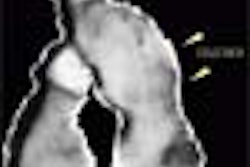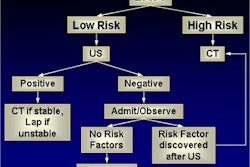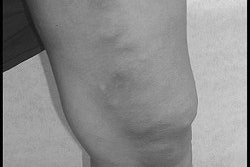(Ultrasound Review) New research has established that color duplex ultrasonography of the temporal arteries is an excellent noninvasive test for diagnosing temporal arteritis. In the U.S., temporal arteritis is the second most common cause of acquired blindness. The American College of Rheumatology has formulated five diagnostic criteria that include temporal artery biopsy, the gold standard for diagnosis:
- Age >50 years
- Sudden onset of localized headache
- Temporal tenderness or decreased pulse
- ESR >50mm/h
- Histologic findings of inflammation
Three of five criteria must be present for diagnosis of temporal arteritis.
However according to Dr. Christopher LeSar and colleagues of Norfolk Surgical Group in Virginia, "surgical biopsy is sought in a population with a relatively low prevalence of disease, yielding a high rate of negative biopsy results."
Thirty-two patients with suspected temporal arteritis were prospectively evaluated with color duplex ultrasound before temporal artery biopsy. Temporal arteritis was characterized by an hypoechoic halo that corresponded to vessel inflammation. Color and spectral Doppler was used to demonstrate inflammatory stenosis indicated by a two-fold increase in peak systolic velocity. Ultrasound was performed using high-frequency linear array transducers. Both temporal arteries were examined medial to the ear and followed superiorly into the frontal and parietal branches over a distance of 60 cm. According to the authors, any sonographer experienced in arterial Doppler examinations could learn this study, which usually took 30 minutes to perform.
No evidence of vasculitis was present in 75% of patients that underwent arterial biopsy. Using the presence of an hypoechoic halo as the only diagnostic criteria, sensitivity was 85.7% and specificity was 92%. When the diagnostic criteria were expanded to include halo sign, an inflammatory stenosis or both the sensitivity increased to 100%, but the specificity decreased to 80%. These results were reported in the December issue of Journal of Vascular Surgery.
"Color duplex ultrasound is a superior noninvasive method of determining the presence of vasculitis when compared with routine surgical biopsy," they said. Temporal arteritis doesn’t always effect the entire artery. Because color duplex examines the entire temporal artery and its branches, it also can be used to direct the best site for biopsy thus resulting in a higher diagnostic yield.
"A positive ultrasound scan result can prompt a directed surgical biopsy, which would minimize the chance of a false-negative biopsy result," they concluded.
The utility of color duplex ultrasonography in the diagnosis of temporal arteritisLeSar C. J. et al
Norfolk Surgical Group, vascular surgery division, Norfolk, VA
J Vasc Surg 2002 December; 36:1154-1160
By Ultrasound Review
May 7, 2003
Copyright © 2003 AuntMinnie.com



















